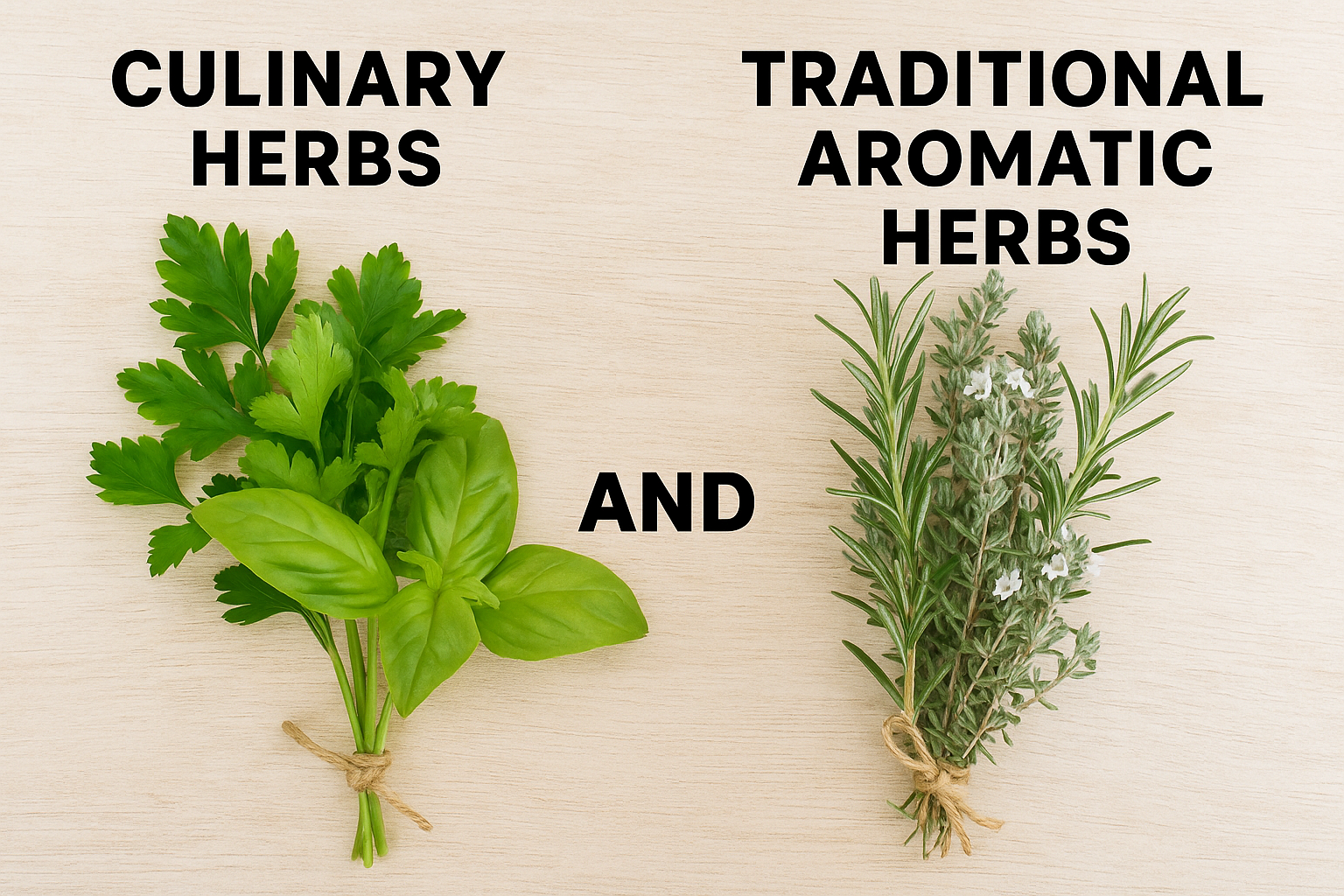Herbs are everywhere in human culture. They flavor our food, heal our bodies, and perfume our homes. But not all herbs play the same role.
In Southern Brazil, there is a clear line between culinary herbs and traditional aromatic herbs. Both come from nature, yet their uses, symbolism, and cultural weight are very different.
Understanding these differences helps us value plants not only as ingredients but also as guardians of identity. While basil, parsley, and oregano enrich meals, marcela, carqueja, and boldinho preserve memory and carry stories.
This article explores what makes culinary herbs distinct from aromatic herbs of the South, how they are used, and why both are important.
What Are Culinary Herbs
Culinary herbs are plants used mainly for flavor. They bring taste, freshness, and aroma to dishes. Their role is to transform food into an experience. Basil lifts tomato sauces, parsley brightens salads, and oregano enriches roasted meats.
These herbs are cultivated widely and globally recognized. They often appear in supermarkets and kitchens worldwide. Their main power lies in taste and in the subtle fragrance released while cooking.
What Are Traditional Aromatic Herbs
Traditional aromatic herbs are different. They are not chosen primarily for taste but for healing and cultural meaning. In the Pampas, marcela calms the body, carqueja cleanses digestion, and guaco helps the lungs. Their scents are used in teas, rituals, and sachets rather than in meals.
These herbs are tied to Gaúcho traditions. Families passed their knowledge orally. A grandmother’s tea, a bundle hanging in the kitchen, or a ritual of burning sage all reflect how aromatic herbs go beyond food.
Key Differences Between Culinary and Aromatic Herbs
Purpose
Culinary herbs are about taste. Aromatic herbs are about healing, memory, and identity.
Usage
Culinary herbs go into recipes. Aromatic herbs become teas, infusions, sprays, or ritual tools.
Availability
Culinary herbs are commercialized globally. Aromatic herbs are often regional, harvested in specific seasons.
Symbolism
Culinary herbs symbolize flavor and freshness. Aromatic herbs symbolize tradition, balance, and spirituality.
Examples of Culinary Herbs in the South
Parsley
Parsley is light, fresh, and used daily. It is chopped over rice, beans, and meats. Its scent is subtle, focused on food rather than ritual.
Basil
Basil thrives in warm climates and perfumes sauces. Its sweet-spicy aroma is a kitchen favorite. But in Gaúcho culture, it is not tied to healing traditions.
Oregano
Oregano adds depth to pizzas and roasted dishes. It is widely cultivated and associated with Mediterranean cooking more than local rituals.
Mint
Mint is refreshing in drinks and desserts. While also used in teas, in the South it is valued more for flavor than for spiritual significance.
Examples of Aromatic Herbs of the South
Marcela
Marcela has golden flowers and a sweet scent. Its tea calms anxiety and insomnia. It is rarely used in food but is essential in rituals, especially around Easter.
Carqueja
Carqueja has bitter stems and an earthy fragrance. Families drink it as a digestive tea. It has no role in cooking but is central in herbal medicine.
Boldinho
Boldinho is refreshing like mint but stronger. It is a classic stomach remedy and a natural air freshener. Its aroma belongs to healing, not to cuisine.
Guaco
Guaco supports breathing and relieves coughs. Its sweet scent is medicinal, not culinary. It grows near homes as a symbol of protection.
White Sage
White sage carries smoky, intense fragrance. It is burned in rituals to cleanse spaces. It is not eaten but revered spiritually.
Cultural Meaning Behind the Distinction
The separation between culinary and aromatic herbs reflects lifestyle. Cooking herbs bring families together around meals. Aromatic herbs bring them together around care, healing, and ritual.
Both kinds of plants express identity. One is linked to the daily act of eating. The other is tied to memory, healing, and faith. This balance explains why Gaúcho households value both gardens and herbal jars.
How Culinary Herbs Entered the South
Culinary herbs like oregano and basil are not native to the Pampas. They came with European immigrants who brought seeds and recipes. Over time, they merged into daily meals but remained separate from traditional rituals.
Aromatic herbs, by contrast, are native. They grew in the fields long before colonization. They belonged to Indigenous practices and later to Gaúcho families.
When Culinary and Aromatic Herbs Meet
Sometimes, the lines blur. Rosemary is both culinary and aromatic. It seasons meat but also symbolizes memory and is burned for protection. Mint, too, crosses boundaries, refreshing desserts while serving in teas for digestion.
These overlaps show that plants are versatile. Yet cultural context decides whether they are seen as food or as medicine.
Practical Ways to Use Both in Modern Life
In the Kitchen
Use parsley, oregano, and basil daily in meals. Add rosemary not only for flavor but also for its sharp aroma. Keep mint for refreshing drinks.
For Healing
Prepare marcela tea for anxiety, carqueja tea after heavy meals, and boldinho tea for stomach relief. Use guaco for colds and white sage for cleansing.
For the Home
Dry aromatic herbs for sachets. Use rosemary sprigs on windowsills. Burn sage for spiritual balance. Culinary herbs can also decorate kitchens and add freshness.
For Personal Care
Infuse aromatic herbs in oils for perfumes. Use basil or mint oils in skin creams. Mix rosemary and marcela for relaxing sprays.
Scientific Perspectives
Studies show oregano and basil are rich in antioxidants that improve food health value. Parsley has vitamins A and C.
Marcela contains flavonoids with calming effects. Carqueja is proven to support the liver. Guaco contains coumarin, beneficial for breathing. Science confirms that both culinary and aromatic herbs carry real power—just in different directions.
Mistakes to Avoid
Using Aromatic Herbs as Culinary Herbs
Not all aromatic plants are safe in food. White sage, for example, is not meant for cooking.
Overlooking Ritual Value
Culinary use is easy to see. Ritual use is harder to value. Ignoring it means losing cultural depth.
Assuming All Herbs Are the Same
Every plant has unique compounds and meanings. Respecting their differences ensures safety and authenticity.
Conclusion
The difference between culinary herbs and traditional aromatic herbs of the South lies in purpose, use, and symbolism. Culinary herbs like parsley, basil, oregano, and mint enrich meals. Aromatic herbs like marcela, carqueja, boldinho, guaco, and sage heal, perfume, and carry tradition.
Both are essential. One feeds the body, the other feeds the soul. Together they form a complete picture of how plants shape Gaúcho life. Recognizing their distinct roles allows us to honor both the taste of food and the fragrance of heritage.

Marcela Cardozo is passionate about Southern Brazilian traditions and the cultural stories carried through natural scents. She blends knowledge of native herbs, essential oils, and regional rituals to create practical and inspiring content. Her writing connects ancestral wisdom with modern living, offering readers simple ways to bring authenticity, well-being, and meaning into their everyday lives.
